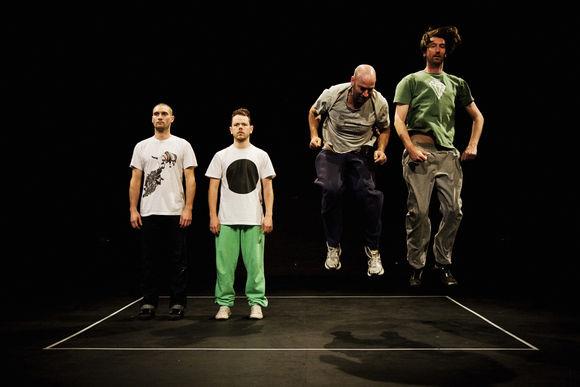Small-to-medium Australian performing arts companies are enjoying a growing international reputation but at a high cost.
For years, it was Australia’s pop musicians, soap operas and indigenous visual artists that captured the imagination of global audiences. Now, the world is starting to sit up and take notice of Australia’s performing arts sector too.
The triumphant opening performance of Back to Back’s Ganesh versus the Third Reich at New York’s Under the Radar festival earlier this year, and its subsequent touring success, has been much celebrated.
But the recent successes of Australian artists and companies extend well beyond Back to Back. Australian dance, for instance, has been particularly successful of late. Lucy Guerin’s Untrained toured to the Brooklyn Academy of Music in December. The Dublin Dance Festival featured an entire Australian showcase, entitled Big Island, Small Island, in May this year. Works included Untrained, Ros Warby’s Monumental and Stephanie Lake’s Dual, and there was also a screening for Irish audiences of Closer Productions’ wonderful tribute to Tanya Leidtke, Life in Movement. Meanwhile, Australian Dance Theatre’s Proximity has been touring Europe as a co-production with the Grand Théâtre de la Ville de Luxembourg and Le Rive Gauche Centre Culturel de Saint-Etienne-du-Rouvray.
According to the Australia Council’s Collette Brennan, we are seeing something of a purple patch in international touring for the small-to-medium performing arts sector.
‘The positive for me is some really classy independent artists coming through,’ Brennan told ArtsHub. Citing Back to Back as an example, she argues that smaller Australian companies have lately been leading the way. ‘The small-to-medium sector has been really sophisticated about where they go, who they fit with, and what they want to do,’ she added. ‘If you think about Back to Back, they’re really driven about their touring: it’s boutique and it’s very well-targeted.’
Brennan says that while the Australia Council’s support programs continue to fund companies to travel to traditional markets in Europe and North America, there is a growing trend towards Asian touring. ‘People are still going places, but it’s not the usual suspects,’ she said. Australia Council data shows that approximately 31 per cent of the agency’s grants are supporting tours to Asia. Brennan describes that as ‘solid progress.’
But it’s not all upside. Touring is great for reaching new markets overseas. It can be lousy for making money. ‘It’s very difficult for companies to get into a revenue positive position from touring,’ Brennan said. ‘A lot of companies will do loss-making tours when they’re entering markets, and we’ll still support those.’ It’s the old Broadway story: you can’t make a living, but you can make a killing.
Other insiders ArtsHub spoke to agreed: it can be very hard to make international touring pay. ‘It’s always financially risky to put anything out there,’ Performing Lines’ Fenn Gordon told us. ‘Visas and taxation are increasingly burdensome and complicated, the lead times are really long, and it takes a lot of energy and effort.’
‘You really need to be very clear about what the benefits are to you as a company and an artist, about why you want to tour your work, and think very hard about whether that gig is right for you,’ she said.
Gordon says that the global economy has not been kind to Australian artists in recent years. The high Aussie dollar and the global financial crisis that has hit northern hemisphere markets particularly hard have both had significant impacts on the viability of Australian work for overseas presenters. ‘In 2008, when the US economy crashed, that was a very bad year,’ she said. ‘In some instances the impacts were absolutely immediate, things we were hearing about were some companies were detrimentally impacted almost immediately, despite the fact they had tours lined up.’
‘We used to be the cheap companies because our dollar was so low,’ Gordon said, ‘and we can’t do that any more.’
According to the Performing Arts Touring Alliance’s Karilyn Brown, ‘the dollar in recent years has been particularly challenging.’
‘It was always thought that the airfare and the freight that would be the tricky bits, and that’s still the case,’ she added. ‘But now it’s hard for presenters to even pay the artist’s fee.’
Brennan says the Australia Council is aware of the issue. ‘I’m getting a lot of feedback that Australian work is expensive, and that’s that impact of the Australian dollar,’ she admitted.
As the economic environment has changed, Australian companies have adapted. Brennan notes that ‘people are having shorter tours, or much more demanding tours, less time in one venue.’ PATA’s Karilyn Brown says that the key for companies and artists is building relationships with presenters. ‘One of the things that was really interesting about the Australian Theatre Forum was an increased focus on the relationship between performers and presenters,’ she pointed out. ‘It’s not just popping in and popping out – it is about engagement.’
For her part, Performing Lines’ Gordon argues that international presenters are now looking to co-investment and co-production models to bring credible Australian work to their shores, pointing to Circa and ADT as examples. ‘Touring is changing now,’ Gordon said. ‘Circa are doing a lot of collaboration and co-production internationally. Once you get to that level of reputation and engagement, then you’ve got access to four or five different investors that will put money into the creation of that work, including Australian presenters.’
Ultimately, international touring is a gamble. But it can pay off. ‘In my experience there’s always been considerable interest in Australian performing arts,’ Brown observed. ‘There’s a strong interest in the innovative nature of much of our work.’





